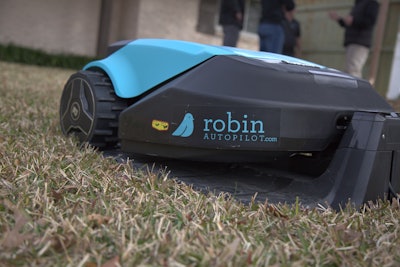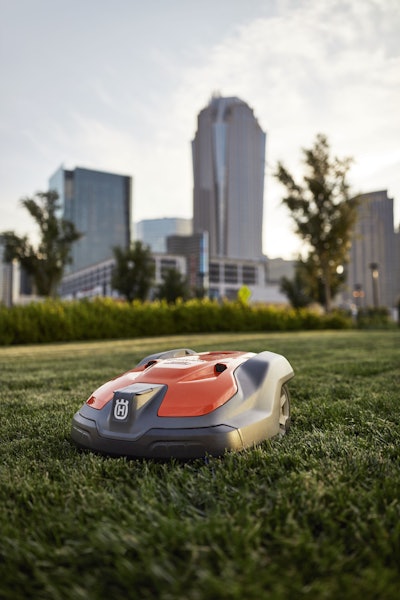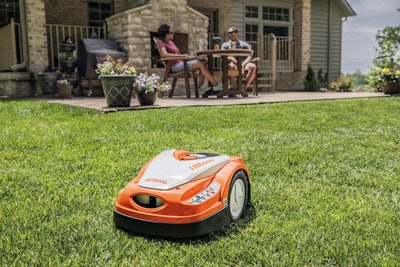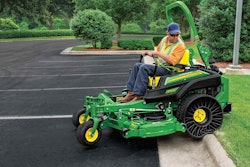 Once the mower has completed its work for the day or needs to recharge, it will return to its docking station on its own.
Once the mower has completed its work for the day or needs to recharge, it will return to its docking station on its own.Photo: Robin Autopilot
Want to download the entire Mower Matchup series, including makes, models and details on dozens of mowers from the editors at TLC?
The debate between using or losing robotic lawn mowers is one that’s been in circulation since Husqvarna first released the machines in the U.S. in 1995.
Total Landscape Care reached out to industry experts to discuss what the introduction of robotic mowers means to the green industry.
Hesitations
It’s just a fad
Landscapers fear that the robotic mower is just a fad, one that will fade out as soon as they purchase one, experts say.
Steven Uljua, product training specialist with Husqvarna, has worked with robotic mowers for several years and at first, he admits he was hesitant to get on board with the idea. But after working with them hands-on, he was convinced that this was no passing trend.
“I’ve never looked back,” Uljua says. “I’ve never felt like this is going to be just something that is not going to be a long-term type of situation.”
Many professional landscapers hesitate to use robotic mowers because of an initial distrust of the equipment, says Kris Kiser, president of the Outdoor Power Equipment Institute (OPEI).
“As with any new product in any field, they’ll adapt,” Kiser says. “Part of it is just getting over the initial shock, but I think you’ll find nothing but good things. Anything that makes the maintenance and care of the managed landscape easier and more innovative is helpful.”
Brian Manke, product manager for robotic mowers with Stihl, says it all boils down to one thing: fear of the unknown.
“(Professional landscapers) can kind of see where this is going and they can see where it’s going to fit in their business, but nobody wants to be the first one,” Manke says. “Some people are just hesitant to embrace that level of technology when they’re used to low-tech items and manual labor.”
 Experts say that by having these mowers take on the task of mowing, your crew is free to do more labor-intensive work.
Experts say that by having these mowers take on the task of mowing, your crew is free to do more labor-intensive work.Photo: Husqvarna
According to Uljua, there are three phases of robotic mower ownership. Phase one is filled with disbelief. You might buy it just to try it out, but you don’t think it will really do the job. Phase two, he says, is the ‘what if’ phase where you really test what the mower can and can’t handle. Finally, the third phase is the investment phase, which is where Uljua says a lot of people start to take a look at their lawns and see how they can take it to the next level.
Uljua says that robotic mowers could help cut down on preconceived notions that all landscapers do is cut grass. By having these mowers take on that task, your crew is free to do more labor-intensive work such as building hardscape projects, planting and maintaining flower beds, installing irrigation systems and more.
“Now you can really concentrate on being a top-notch landscaper and offer other services,” he says.
Uljua also notes an upsell to offering robotic mowers: customers have a regularly mown lawn that always looks the same.
“End users are not overly thrilled with someone they don’t know in their backyard or around their house,” he says. “So, taking that off the table and introducing them to the robotic mower takes away that intrusiveness of strange people at their facility.”
The robots are taking our jobs
When these mowers were first introduced at GIE+EXPO, Uljua says they were seen as a joke by professional landscapers. In the second year, landscapers believed the robots were taking away jobs. Last year, though, he noted a shift in thinking. Many landscapers were now looking to these mowers as a way to help supplement the labor shortage.
“It only mows grass; it’s not going to eliminate jobs,” he says. “You’re still going to have to trim hedges, you still have to blow the driveway, there’s still so much work.”
 One thing that the Automower offers some is the ability to trim slopes that other mowers can’t handle.
One thing that the Automower offers some is the ability to trim slopes that other mowers can’t handle.Photo: Husqvarna
Manke says the idea of using a robotic mower is similar to that of an assembly line. People are required to work on an assembly line alongside robots, and the robots are there to complete the tasks that can’t be done as efficiently by humans. When the two work in tandem, they create a dynamic team.
“(Landscapers) are being forced into (using robotic mowers) because of the labor lows we’re experiencing in this country,” says Manke. “They’re looking for solutions, so the robotic lawnmower becomes a piece of that puzzle to solve that problem.”
As a company that only runs robotic lawn mowers, Justin Crandall with Robin Autopilot, America’s first robotic lawn care service company, says he’s seen the financial benefits of only having to have a handful of employees to maintain his fleet of robotic mowers.
Instead of having to try and find more qualified landscape professionals in the midst of a nationwide labor shortage, he’s instead been able to successfully work with a smaller crew while still accomplishing multiple lawns.
“One of the reasons we went down the path of taking on this challenge (of being a robotic lawn care company) is because we see the benefits,” Crandall says. “We’ve reduced the amount of labor hours necessary to service (the robotic mower) by over 80 percent.”
Other concerns
The majority of mower manufacturers have expressed that they do think robotics will eventually be helpful and even possibly a solution for landscape contractors, but currently they still think there are improvements to be made.
“There are a number of important areas where robotic mowers come up short today, including cost, speed, efficiency, battery life and finished cut appearance,” says Jamie Briggs, director of marketing for Exmark.
Gravely’s main concern is that the robotic mower must be able to provide great results while guaranteeing that it can be operated safely.
Briggs points out that a switch to robotic mowers would require a change in business models for most landscape contractors but Tom Vachal, Kubota senior turf product manager, says robotic mowers might provide a way to free up crew members to handle other tasks if visual recognition is improved.
“Visual recognition still needs more development, knowing what to cut and not to cut; how close to cut to some feature is a big deal for many customers,” Vachal says. “Knowing what the expected result is for a person mowing is easy to explain and understand. How do you tell a robot mower that you would like it a little shorter or taller? Then what happens?”
Bob-Cat agrees that robotic mowers might be helpful in certain scenarios but thinks charging times, cut-widths and the length of time it takes to mow a yard will have to improve before autonomous mowers can help with the labor shortage. Ron Scheffler, Bob-Cat’s senior product manager, also doesn’t think robotic mowers will ever usurp landscapers.
“Nothing replaces the human experience or touch,” Scheffler says. “In a highly landscaped area, a landscaper will still need to do the trimming and finishing touches on a lawn. This can only be done by the professional who understands what the customer desires for their property. I don’t believe a customer wants to pay for a robot. Customers want to pay for a personal touch on their lawn.”
Other manufacturers may remain dubious, but Husqvarna says that in just the past year, they have seen a significant change in attitude toward robotics in the industry.
“We’re now seeing a level of interest and understanding that we didn’t see before,” says Sean Dwyer, director of product development for Husqvarna. “Lawn care companies now recognize that a product like our commercial model, Automower 550, can be a real solution for their labor shortage and help them streamline operations, focus their crew on more complex tasks and provide their clients with an entirely new way to keep their lawn in perfect shape all the time.”
Benefits and downsides
Overall, the experts say that when it comes to robotic mowers, the benefits far outweigh the downsides.
Customer appeal
Crandall says that one of the biggest positive notes about these mowers is that customers absolutely love them. Even after a rainy day, Crandall says the mower won’t be delayed in its cutting ability, and the mower is quiet enough it can still do its job at night without disturbing your customers or surrounding homes.
 One of the biggest positive notes about these mowers, experts say, is that customers absolutely love them and enjoy watching them work.
One of the biggest positive notes about these mowers, experts say, is that customers absolutely love them and enjoy watching them work.Photo: Stihl
Crandall adds that because of the high frequency of mowing these machines offer, your customer’s lawn will always look fresh and better in color. Along with these benefits, Crandall says people, in general, just love robots.
He’s seen his customers time and again become so attached to their little bots that they name them, sit around for hours watching them mow and even build specialized docking homes for them to return to.
This, he says, gives you free viral marketing, as customers are likely to share photos and videos of their robots via social media sites and tag your company in the posts.
Easy peasy
The ease of repair and maintenance is another aspect that professionals agree plays in favor of the robotic mowers.
Stihl has a training program in place for dealers that sell their iMow, Manke says. These dealers are required to take a three-day training class on the machine to learn how it works, and how to repair and maintain it.
Because these mowers are battery-powered with brushless motors and lithium batteries, there isn’t a lot of required maintenance, Manke says. The main items you’ll have to replace periodically are the blades.
You should also occasionally check the mower for materials that may have wrapped around the wheels. Yearly maintenance typically consists of checking connections and ensuring no corrosion has occurred on the wires. If something does break, Manke says repairs can typically be finished in about 30 minutes.
Uljua adds that there will be some computerized updates that will need to be installed, but users can simply take their mower to a dealer, plug it in and update it on the spot.
The typical life expectancy for these machines, depending on the severity of the elements it’s working in, can range from five to 10 years, experts say.
Installation
Uljua says there are two ways the wires required by robotic mowers can be installed in a landscape. One is to staple the wire down with plastic staples. Within a few weeks, the grass will absorb the wire and it will work its way down into the soil.
The second way is to bury the lines about 2 or 5 inches into the ground, depending on your installer. Robin Autopilot’s guidance system can be embedded 4 to 5 inches before distortion occurs, according to Crandall, but he says the standard depth is 2 inches.
Manke says Stihl currently requires these wires to be installed by a certified installer, done exclusively through their dealer network.
The Husqvarna robotic mowers are embedded with GPS mapping, which means as it mows the property, it’s learning which ways it should and shouldn’t go. Uljua says it takes about two weeks for the mower to learn a property.
Eventually, the hope is to have the wiring removed completely from robotic mower use, but Uljua says the unreliability of GPS keeps this from being possible at this time.
“The pinpoint accuracy’s not there, but we are continually working with different technologies and one is to eliminate the boundary wire,” Uljua says.
Theft
“What happens if someone just decides to walk off with my mower?”
This is a question all robotic mower specialists/salespeople have heard, and the simple answer is: It’s useless to a thief.
While it’s possible that the mower could be stolen, the thief won’t get very far with it due to the GPS trackability. They also won’t be able to use it due to the serial and PIN numbers required for operation.
Uljua says that the mowers sound an alarm if they are picked up. He adds that if the machine is picked up and carried over the boundary wires, users will be able to see a record of precisely what time and where it was picked up.
Return on investment
It can sometimes be difficult to sell landscapers on the larger upfront price of the mowers, however.
 The Automower 550H can mow up to 1.25 acres and handle 45 percent slopes. It has an MSRP of $3,699.95
The Automower 550H can mow up to 1.25 acres and handle 45 percent slopes. It has an MSRP of $3,699.95Photo: Husqvarna
Uljua says the Automower 450 model costs approximately $3,499 and can mow about an acre and a quarter throughout the day. The Automower 310 model costs approximately $1,799 and can mow about .3 acres of yard.
While the upfront cost might be high, the mower will pay for itself in two to three years, experts say.
“The economics work either if you have lots of capital to put in upfront or if you can finance the robots over a period of time,” Crandall says. “The big payoff comes in those later years.”
It can be difficult to convince landscapers that robotic mowers are here to stay, but Uljua encourages them to push the envelope and do something different from their competition.
“I get it; it’s very new, different and unusual,” says Uljua. He suggests that landscapers take a toe-in-the-water approach if they’re hesitant. “Because if you don’t, your competitor will. You might as well be the leader in your area and be the one that everybody else is chasing,” he says.
Crandall says while robotic mowers aren’t a perfect fit for every lawn and every customer just yet, he’s optimistic that once the early adoption phase has passed, more customers will be drawn to these machines.
“There’s an education process that they have to go through,” Crandall says. “But generally, what you find with technological progress is that the insiders know about it first and don’t use it. Consumers start buying it, start adopting it and very quickly, different companies start pushing it forward.”
EDITOR’S NOTE: This is one of the articles found in Mower Matchup. Mower Matchup was created to delve into the pros and cons of various mower features and provide a comprehensive look at popular mower manufacture specs. Click here to download the full Mower Matchup series.











